 Please clean their containers often - it is not good for them to live in their own waste. The Egg
Keep the plant stem in water. It may last longer if you cut the end of the stem just before putting it in water. If you have just taken the leaf, keep it on a moist paper towel or filter paper in a petri dish or any other clean container. Keep the container covered to maintain modest moisture. Check each day and add water a drop at a time to the filter paper if necessary. The top of the egg will look dark before the larva is ready to emerge. Be sure to have a fresh milkweed leaf in the container for the new larva, if its old leaf is dry. The Larva (Caterpillar) Once the larvae emerge, they will need fresh milkweed leaves. They won't eat any other plants, although they do eat many different species, or kinds, of milkweed. If the original plant is still fresh, it is easiest to just leave the larvae on this for a few days. They rarely crawl far during this time, and do not need to be put in a container until they are about four days old. If you are keeping larvae in individual containers, be sure to replace leaves when they turn dry, every one to two days. Leaves will keep longer if the stem is wrapped in a moist paper towel and then wrapped in tin foil or plastic wrap. Containers should be emptied of frass (larva waste) every one to two days.
Larvae can be handled safely with fingers after they are about three to four days old, but it is best to handle them as little as possible until they are over an inch long. If necessary, a moistened artist brush can be used to transfer younger larvae without hurting them. Larvae of any size should not be handled when they are molting. They are getting ready to molt when they remain very still, often on the side or top of their container, and when you can see their black head capsule about to come off. Just after they have molted, their tentacles will look droopy, and you may see the old skin behind the larva. They will usually eat this skin!
There is some mortality in the larval stage. One bacterial disease causes the larvae to turn very dark, and then die. Others may simply stop eating and growing, and then die after for several days. While this may be difficult for the students to accept, you can assure them that as long as they have been keeping the containers clean, it is not their fault. Remove dead larvae and clean their containers well to prevent the spread of disease. The Pupa (Chrysalis) When larvae are ready to pupate, they crawl to the top of their cage, attach themselves with silken thread, and form a prepupal "J" before shedding their skin for the last time. This process is fun to watch but it happens quickly. You can tell that they will shed their larval skin soon (within minutes) when their tentacles hang very limply and their bodies straighten out a little.
The adult will emerge in 10-14 days. When it is ready to emerge, the adult wings will be visible through the pupa covering.
The Adult Butterfly
While monarchs can spread their wings and dry sufficiently to take a short flight after 90-120 minutes, it is best to wait 24 hours to release them. A monarch's first short flight soon after emergence allows them to reach a dark and protected spot where they rest the remainder of the day unless disturbed. They don't feed, they just sit. They need time to mature all their systems, including eyes, chemoreceptors, neuromuscular connections, etc. and a 24-hour or more period is needed before they are fully flight capable. This maturation period applies to nearly all insects. It is best if monarchs are released on a warm sunny day, near flowers if possible. If it is colder than 60o F, they often cannot fly. If you keep the adults, they should have a cage large enough to allow flight. Hanging or wooden frame cages are examples of cages that work well for adults. Adults do not need to be fed until the day after they emerge. After this they should be fed daily. They can be fed in a variety of ways. Fresh cut flowers can be placed in containers and put in the cage, a small dish or jar lid containing a sponge saturated with a 20% honey/water solution can be set in the cage, or fresh fruit such as watermelons, honeydew or cantaloupe melons can be cut and set in the cage. These should be changed daily to prevent fermentation. "Juicy-Juice" purchased from a grocery store can substitute for the honey water solution. We also have a non-fermenting artificial nectar mix available. To encourage feeding in any of the above methods, place the front feet into the solution and the butterfly will sometimes unwind the proboscis and start feeding. If the butterfly does not unwind its proboscis after several tries, place a probe or pin in the loop of the proboscis and pull the pin away from the head so the proboscis is extended and touches the honey solution. Once the proboscis is in the nectar solution, the butterfly is feeding.
Adult mass can be measured using a triple beam balance (nearest 0.1g) or an electronic balance (nearest 0.01 g or 0.001 g). In both cases the butterfly should be placed in an envelope while it is being weighed. Be sure to subtract the mass of the envelope. The length of the forewings can also be measured; measure to the nearest millimeter from where the wing attaches to the thorax to its tip, or apex. It is interesting to measure both the right and left forewings and to note the degree of asymmetry (how different the two wings are on each butterfly). See Size and Mass for more info. |
MONARCH WATCH REARING KIT |
|
Monarch Watch Monarch Rearing Kits can be used for educational purposes in schools, homes, or other settings. For example, classroom instruction, student projects or other educational activities. Monarch Rearing Kits (available via the Monarch Watch Shop here) contain 14-16 first to third instar monarch larvae (caterpillars) that were started on an artificial diet. Upon arrival, these larvae should be transferred to larger containers and provided with milkweed leaves. Monarch larvae will feed on all commonly available milkweed species (but do not confuse these with other plant species with a milky sap). Milkweed plants can be collected in the field (cut stems) and stored in a refrigerator in plastic bags for 4-5 days. Leaves should be rinsed and dried before feeding. Do not feed the larvae leaves that are yellow, dried out, or moldy. If the milkweed plant has not been in your care, leaves should be washed in warm, soapy water, rinsed well, and dried before feeding. This will help prevent illness and death of the caterpillars due to pesticides. (Please note: Plants that have been sprayed repeatedly or sprayed heavily may contain residual pesticide that will harm the larvae, even with washing.) Rearing Containers Monarch larvae can be reared in many different types of containers, such as aquaria, glass jars, plastic food containers, etc. Rearing containers should be at least three inches deep and should have ventilated lids (use either mesh lids or poke holes in the lid). Larvae will survive best and attain a large size if you keep the food fresh, the container clean, and the humidity and crowding low. Controlling humidity is very important. If the humidity is too low your leaves will dry out and will not be a good food source; if the humidity is so high that condensation forms in the container, mold may develop on the frass (feces) and/or the leaves. These conditions seem to favor the development of diseases that could spread rapidly from larva to larva. Your larvae will do best if only a small number are reared in each container. To minimize the possibility of cross-contaminating containers, DO NOT transfer larvae from one container to another. Should a larva die of an apparent disease, for example lose its shape and color, transfer the healthy larvae to a clean container with new leaves and clean the container with the dead larva with hot soapy water or bleach. You can find examples of rearing containers and cages below. An easy rearing method, which requires less daily care, is to place the larvae on milkweed whose cut stems are placed in water in narrow necked bottles – 2-liter plastic bottles work great. First, cut the milkweed stems twice under warm water; this will keep the milkweed fresh. This treatment has the effect of keeping the latex that typically forms on a cut stem from plugging the vesicles that transport water to the leaves. To keep larvae from going down the stems and drowning in the water, wrap the stems with a paper towel so that it fits snugly into the neck of the bottle. The bottles can then be placed in screened cages. A variation on placing the bottles in a cage is to construct a container of two plastic 2-liter bottles. This rearing container is made by 1) cutting the bottom off of one of the bottles, 2) drilling/cutting a 3/4 inch hole in each of the bottle caps and gluing them together (top to top) with a strong adhesive. Fill the bottom bottle with water, screw on the caps, attach the other bottle and add the plant stem. The top opening can be covered with screen or any other porous cover - we use a small square of open-mesh shelf liner. Four to six larvae can complete their development in this container. The plants should be changed as needed, usually every two to three days. To rear monarchs outdoors on living plants outdoors you will need to protect the larvae from numerous parasites and predators. Protection can be provided by using mesh "sleeves" with draw-strings on either end. The sleeve is placed over a plant, the larvae placed inside, and the drawstrings tied tightly. This method works well and little care is involved. Rearing Conditions The larvae you've received should be transferred to a rearing container with milkweed as soon after their arrival as possible. To transfer the larvae, open the cups and use a fine paintbrush, toothpick or forceps to gently transfer the larvae to a suitable rearing container. Alternatively, you can add leaves to your rearing containers and place the open cups inside. The larvae will then crawl from the cups to the leaves. Line the bottoms of the containers with paper towels. Add 2-3 leaves to each container and provide new leaves and a new paper towel every day or as needed. Once the larvae have reached the last (5th) instar stage (approximately 1" in length), they will feed rapidly and can quickly run out of food. Watch the containers closely at this stage; you may have to feed the larvae twice a day. Development times of larvae depend on the temperatures at which they are reared. At room temperature, the larvae should pupate 10-14 days after you receive them. Generally speaking, lower temperatures translate into longer development times and higher temperatures decrease development time. Pupation and EmergenceWhen the larvae have finished growing, they will spin a small silk button, or pad, at the top or side of their container. The larvae will hang upside down from this pad and will assume the J-shaped position of the prepupa. Do not disturb the monarchs when they are preparing to molt to the pupal, or chrysalis, stage. The pupae usually form in morning hours (9-11 am) or later in the day (5-7 pm). You will notice the larva expanding until its skin splits to reveal a green cuticle. This cuticle hardens and the larva will become a pupa, also called a chrysalis. If the pupae are kept at room temperature, the butterflies should emerge from the chrysalis within 10-14 days. Again, cooler temperatures will delay emergence and warmer temperatures will shorten the amount of development time required. An emerging monarch will cling to its pupal case. At first, the butterflies are soft and their wings wrinkled and pliable. Their abdomens will be large and you may notice the abdomen pulsating as fluid is pumped from it into the wings, until the wings are fully expanded and become stiff. It usually takes 1-2 hours for a monarch's wings to harden sufficiently for flight. The new adults are relatively inactive and do not need to be fed the first day. During the first 24 hours the wings will harden and the sensory mechanisms (eyes, odor receptors on the antennae, and taste receptors on the ends of the leg - yes, butterflies taste with their feet!) will become fully functional. You may want to consider moving your pupae from rearing containers into emergence chambers. This will ensure each butterfly has enough room to dry and expand its wings and will help prevent the spread of disease. The pupae can be moved after they have hardened, about 48 hours after pupation, by gently pulling up the silk pad with forceps. Once they have emerged, the monarchs can be released or can be used for classroom instruction, student projects, or to start a breeding population in the classroom. Emergence Cages When the adult butterfly emerges, it must be able to hang with its wings downward to facilitate their expansion. Therefore, pupae must either be hung vertically or placed near a rough vertical surface to climb onto. Picnic food protectors (available from some drug and discount stores) make good emergence cages. A pizza box with a rough surface (screen, washcloth, etc) on the bottom can be used for a base. The pupae can be hung (attach tape to the silk strands at the end of the pupa or tie dental floss around the cremaster - the end of the pupa that attaches to the silk) inside the food protector or placed flat on the bottom of the box. If the pupae are hung by the cremaster, the new butterflies will cling to the pupal case as in the wild. If placed on a rough surface, the new butterflies will crawl across the bottom and climb up the walls of the food protector to expand and dry their wings. Individual emergence cages can be constructed by gluing window screen inside a 12 oz or larger clear plastic cup. The butterfly will use the screen to climb up on when it emerges from its chrysalis. The edge of the screen should extend to the bottom of the cup and the cup should be placed over the pupa on a paper towel or other rough surface. Adult Feeding and Maintenance The newly emerged adults will not need to be fed the first day, but the next day they can be fed a sugar-water or honey-water solution. Mix 1 part sugar or honey with 9 parts water and pour into a shallow dish. A plastic pot scrubber should be placed in the dish to aid in feeding. The food must be changed every day to prevent fermentation. As an alternative, you can buy an artificial nectar mix from Monarch Watch. This artificial nectar will not ferment; therefore, you only need to top it off every 2-3 days. If you have a large cage, the butterflies can learn to self-feed; the feeding solution should be placed near the top of the cage and relatively close (within 20 inches) to the light source. Like most insects, monarchs will fly toward lighted windows or artificial lights. The butterflies will live for 2-3 weeks if they are well fed, but they may live as long as 6 weeks if the temperatures are cool enough and you take good care of them. |
IDEAS FOR CAGES |
|
Monarch larvae can be reared in many different types of containers. They can be started (but not finished) in plastic petri dishes, or reared in aquaria, glass jars, etc. The trick is usually keeping the food fresh, the container clean and the humidity and crowding low. An easy method, which requires less daily care, is to place the larvae on entire milkweed plants in pots or whose cut stems are placed in water. These plants are then either placed in screened cages or covered with mesh paint strainers and tied around the base. There are many ways to make simple cages. One method uses wire tomato supports. These are cheap, usually less than $1.00. The frame is used upside down and the tines, which normally are pushed into the ground, are cut off or bent down. To cover these frames make a "sleeve" from see-through dacron or nylon curtain material. The sleeve material is 44"x44". A loop to hold down strings is sewn at each end and the sleeve is then sewn into a tube. The sleeves can be placed over the frame containing the plant and the draw strings tied tightly at each end. Alternatively, the wire frame can be placed so that the bottom rests inside a pizza box filled with clean dry sand. The sand acts as a litter box and the larvae can't crawl under the frame edge if its pushed into the sand. A similar method can be used to rear Monarchs outdoors on living plants. A sleeve with drawstrings at either end can be placed over a plant, the larvae placed inside, and the drawstrings tied tightly. This method works well and little care is involved. If you don't wish to make sleeves, you could use 5 gallon paint strainers which can be purchased from a local paint or hardware store. The paint strainers with elastic at the open end work best. The larvae are placed in the end of the strainer which is then placed over the milkweed. A baggie tie is used to close the open end of the bag around the stem of the plant. Emergence Cages Another cage that we use for emergence in the lab is shown in the figure at right. A plastic 2-liter bottle is cut and a strip of fiberglass window screen is placed on the inside for the butterfly to climb up on when it emerges from its chrysalis. This is then placed on a paper towel or other rough surface and the pupa is placed inside as described above. Wooden Frame Butterfly Cage
Assembly Instructions 1) Double stitch fuzzy side of Velcro on three sides of 2' X 1' piece of the screening. 2) Nail posts onto corners of one of the plywood boards. Nail other board onto the top of the posts. 3) Screw brackets into corners, attaching 2 brackets per post. It's easiest to use a power drill with screw attachment. 4) Wrap large piece of screen around three sides of cage (all but the front), attaching screen with 5/16" staples to the posts. There will be overlap of screening at the top and bottom of the cage. This will be tucked under the molding. 5) Staple three strips of velcro to the front of the cage, on the outside edge of the two front posts, overlapping the screening, and on the bottom plywood edge. 6) Attach the front screening panel using the Velcro and attach the top edge with staples. 7) Finish the cage by attaching molding. Staple, with 9/16" staples, the square edge molding to the top and bottom edges, covering all edges except the bottom front edge where Velcro is attached. Hanging cage
Assembly Instructions 1) If using a hanger, bend into a circle. 2) Cut a rectangle of netting large enough to go around the cardboard and the hanger, with several inches of overlap. 3) Close the netting around the cardboard and tie off the end. 4) Attach the hanger or embroidery hoop to the netting with paperclips. 5) Tie off the top of the cage with rope. 6) Finish by using toothpicks to connect the overlapping flaps.
The attachment cord allows you to suspend cages under lights or in lighted windows. These cages should be suitable for mating and egg laying. Give it a try! |
All material on this site © Monarch Watch unless otherwise noted. Terms of use.
Monarch Watch (888) TAGGING - or - (785) 864-4441
monarch@ku.edu
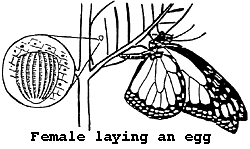 Monarch butterfly eggs are somewhat difficult to find in the wild. Since it only takes 3-5 days for eggs to hatch, timing is crucial. The best sign is to watch for adult Monarchs stopping at milkweed plants. A female will usually lay only one egg per milkweed plant to ensure enough food for each larva. The egg is usually laid on the underside of the leaf, and females prefer young plants. If you do find an egg, it is best to collect the entire plant, and put its stem in water as soon as possible. If necessary, you can just take the leaf on which it is resting. If Monarchs are reared in captivity, females will lay dozens of eggs on a single plant.
Monarch butterfly eggs are somewhat difficult to find in the wild. Since it only takes 3-5 days for eggs to hatch, timing is crucial. The best sign is to watch for adult Monarchs stopping at milkweed plants. A female will usually lay only one egg per milkweed plant to ensure enough food for each larva. The egg is usually laid on the underside of the leaf, and females prefer young plants. If you do find an egg, it is best to collect the entire plant, and put its stem in water as soon as possible. If necessary, you can just take the leaf on which it is resting. If Monarchs are reared in captivity, females will lay dozens of eggs on a single plant.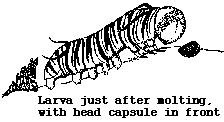 For more information on finding and growing milkweed, see our
For more information on finding and growing milkweed, see our 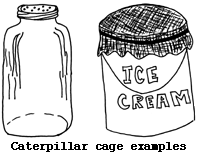
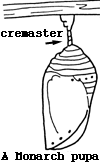 If desired, you can move the pupa after it has formed. Wait until it is hard and dry (several hours or longer). Tie a piece of thread around the cremaster and with a needle or pin carefully tease away the silk that is holding the pupa to the surface. Leave the silk attached so the thread does not slip off (see figure below). If the pupa has fallen and there is very little silk remaining, add a drop of glue to the thread where it surrounds the cremaster. The loose ends of thread can then be tied through a hole in the container cover or through a space in the netting. Clothes pins can also be used to hold the loose end of the thread to a ring stand or other similar object. If you have been weighing the larva, it is interesting to weigh the pupa too.
If desired, you can move the pupa after it has formed. Wait until it is hard and dry (several hours or longer). Tie a piece of thread around the cremaster and with a needle or pin carefully tease away the silk that is holding the pupa to the surface. Leave the silk attached so the thread does not slip off (see figure below). If the pupa has fallen and there is very little silk remaining, add a drop of glue to the thread where it surrounds the cremaster. The loose ends of thread can then be tied through a hole in the container cover or through a space in the netting. Clothes pins can also be used to hold the loose end of the thread to a ring stand or other similar object. If you have been weighing the larva, it is interesting to weigh the pupa too.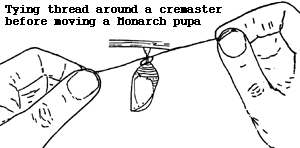
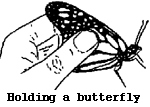 Adults usually emerge in the mid-morning. When the pupa is very dark and the orange and black wings are visible, check it often to increase your chances of observing this amazing event. Some Monarchs die in the pupa stage. If your pupa has been very dark for over 48 hours, it is probably dead. Allow the newly emerged adult plenty of time to inflate its wings and for the wings to dry before handling (3-4 hours). To hold a butterfly, always hold all 4 wings at once in their vertical position. Despite what you may have heard, it is alright to handle Monarchs, even touching their wings, if you do it carefully. Because they live a long time, and many of them withstand a rigorous migratory flight, they are relatively sturdy. A few scales may come off during handling, but this will not hurt the butterfly. Many other butterflies and moths are much more fragile.
Adults usually emerge in the mid-morning. When the pupa is very dark and the orange and black wings are visible, check it often to increase your chances of observing this amazing event. Some Monarchs die in the pupa stage. If your pupa has been very dark for over 48 hours, it is probably dead. Allow the newly emerged adult plenty of time to inflate its wings and for the wings to dry before handling (3-4 hours). To hold a butterfly, always hold all 4 wings at once in their vertical position. Despite what you may have heard, it is alright to handle Monarchs, even touching their wings, if you do it carefully. Because they live a long time, and many of them withstand a rigorous migratory flight, they are relatively sturdy. A few scales may come off during handling, but this will not hurt the butterfly. Many other butterflies and moths are much more fragile.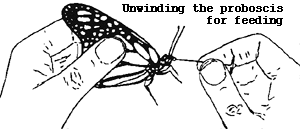
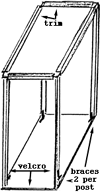 Materials:
Materials: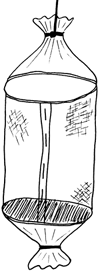 Materials
Materials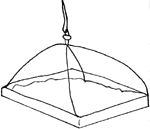 Picnic food protectors (available from some drug and discount stores for less than $1.50) make good emergence cages. Again, use a pizza box as a base, but put a rough surface (screen, old wash cloth, etc.) on the bottom. The pupae can be hung (attach the silk on the inside of the food protector, or the pupae can be placed on the rough surface at the bottom of the box. The new butterflies will crawl up the walls of the food protector to expand their wings.
Picnic food protectors (available from some drug and discount stores for less than $1.50) make good emergence cages. Again, use a pizza box as a base, but put a rough surface (screen, old wash cloth, etc.) on the bottom. The pupae can be hung (attach the silk on the inside of the food protector, or the pupae can be placed on the rough surface at the bottom of the box. The new butterflies will crawl up the walls of the food protector to expand their wings.